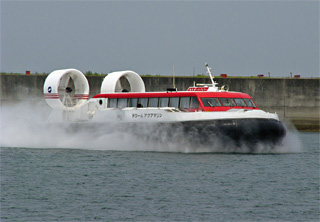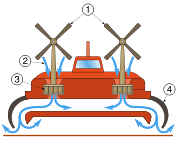Introduction
A hovercraft is a vehicle that glides over a smooth surface by hovering upon an air cushion. Because of this, a hovercraft is also called an Air-Cushion Vehicle, or ACV. How is the air cushion made? The hovercraft creates vents or currents of slow-moving, low-pressure air that are pushed downward against the surface below the hovercraft. Modern ACVs often have propellers on top that create the air currents. These currents are pushed beneath the vehicle with the use of fans. Surrounding the base of the ACV is a flexible skirt, also called the curtain, which traps the air currents, keeping them underneath the hovercraft. These trapped air currents can create an air cushion on any smooth surface, land or water! Since a hovercraft can travel upon the surface of water, it is also called an amphibious vehicle. Figure 1 below shows a picture of a modern hovercraft and a diagram showing how the air vents create the air cushion.


Figure 1. This image on the left shows a modern style hovercraft which carries passengers over the surface of the water, while the diagram on the left shows how the air vents moving through the hovercraft create the air cushion below the craft for movement using the following labels: 1) propellers, 2) air currents, 3) fan, and 4) flexible skirt. (Wikipedia, 2007)
How does the air cushion beneath the hovercraft allow the vehicle to glide to freely? The key to the ease of movement is reducing friction. A simple way to think of friction is to think about how things rub together. It is easier to rollerblade on a smooth sidewalk than a gravel path because the sidewalk has less friction. The wheels of the rollerblade do not rub as much against the sidewalk as they do all the pieces of gravel on the path. Similarly, the air cushion beneath the hovercraft greatly reduces the friction of the vehicle, allowing it to glide freely upon the land or water below.
In this aerodynamics and hydrodynamics science project, you will build your own mini hovercraft using a CD or DVD, pop-top lid from a plastic drinking bottle, and a balloon. The balloon will create the air currents the hovercraft needs to work. These air currents will travel through the pop-top lid and go beneath the hovercraft. You will fill the balloon up with different amounts of air to test if more air will cause the hovercraft to travel for longer periods of time. A balloon blown up with a lot of air will provide a large volume of air, and a balloon blown up with less air will provide a smaller volume of air. Will a balloon with a large volume of air make the hovercraft travel longer than a balloon with a smaller volume of air?
Terms and Concepts
- Hovercraft
- Air cushion
- Friction
- Volume
Questions
- How does a hovercraft work?
- How do the air currents in a hovercraft reduce friction?
- Do you think the volume of air in a balloon-powered hovercraft is important for how long the hovercraft can hover?
Materials and Equipment
- Pop-top lid from a plastic drinking bottle, sometimes found on reusable plastic drinking bottles. Alternatively, a male straight valve with the dimensions 3/8-inch OD x 3/8-inch MPT (PL-3042) can be used. This valve is available at some hardware stores
- An old CD or DVD that you do not mind destroying
- Craft glue, like Elmer's® Craft Bond Tacky Glue, or epoxy that works with plastics, like Elmer's® Super Fast Epoxy Cement. If you use a pop-top lid you can use either the craft glue or epoxy, but if you use the straight valve you should use epoxy.
- Medium-size balloons (should be able to inflate up to at least 11 inches)
- Optional: Balloon pump
- Stopwatch
- Large flat surface for testing the hovercraft
- Lab notebook
No comments:
Post a Comment